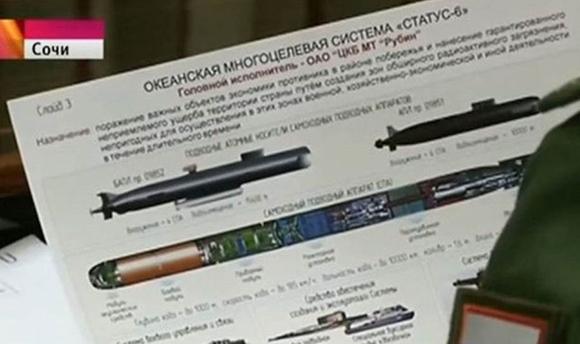The world's first submarine ballistic missile, the code-named Status-6 Kanyon for the Pentagon, it would have been tested on November 27 during a secret operation. For the US intelligence agencies there would be no doubts: to have been launched from a class submarine Sarov, project 20120, would have been theOcean Multipurpose System: Status-6.
Let's go in order. During the filming of the meeting between Vladimir Putin and the defense officials, which took place in Sochi on November XNUMX last year, some Russian broadcasters "carelessly" resumed (see opening frame) the information of the ultra-secret project between the hands of a general. Particularly moderate was the reaction of the Kremlin spokesman, Dmitry Peskov: "True, classified information was captured by the cameras. We had some of them deleted, but we were unable to withdraw the entire footage. We hope that this will not happen again in the future. future. ”Few believed that such a project had escaped by a fortuitous coincidence the Russian military, considering that the meeting focused precisely on the countermeasures to be adopted in a hypothetical confrontation against NATO and the United States.
If the test detected on November 27 by the Pentagon concerned the Status-6, the one that took place a year ago would have been a colossal disinformation operation aimed at deceiving the United States. In the video released, in fact, the sea test of the prototype was postponed to 2019.
THEOcean Multipurpose System: Status-6, is a nuclear-powered radioactive torpedo capable of contaminating economic targets on enemy coasts such as fishing areas. According to the official description of Moscow, the system Ocean Multipurpose System: Status-6 was designed to "cause unacceptable damage, contaminating large enemy coastal areas and rendering them completely lifeless for long periods of time".
The first prototype, contrary to what was previously assumed, would have been tested.
Status-6 should have a range of 10.000 kilometers, a diving capacity of 100 meters and a speed of XNUMX knots: it would certainly be able to bypass the NATO defense system. It is clearly a submarine ICBM with a cobalt warhead, a strategic nuclear weapon.
Status-6 was designed to be an automatic retaliatory missile system. Should the US wipe out the Russian leadership with a preemptive strike, the Status-6 would be launched from the depths of the sea. It is clearly atomic warfare reasoning, with factions now having nothing to lose. It is clear that even if the US preemptively attacked, it would still be hit, at best, by at least one hundred Russian nuclear warheads.
Status-6 would be just one more thought, but certainly not the worst. Status-6 is not only one of the many weapons in the Russian strategic inventory, but it is the definitive one for its ability to create long-term radioactive dead zones. Its cobalt warhead would be devastating to natural resources such as fishing and oil fields offshore. Status-6 was designed to starve survivors of a nuclear holocaust from the sea.
Even on submarines capable of launching Status-6, the Russians may have carried out a red herring operation. It was initially thought that K-6 would launch Status-139 Belgorod and Khabarovsk, submarine evolutions of the class Oscar II. Of the K-139 we know that it should carry out retaliatory missions, while of the Khabarovsk, 09851 project, similar to the class Borei, we know almost nothing. The US intelligence agencies, however, say that the launch of the nuclear-powered prototype was the B-90 Project 20120, an experimental submarine compatible with the type of operation carried out on 27 November last.
Project 20120, inspired by the PL 877B project, implements a radically different propulsion from any other submarine in service. The standard diesel-electric propulsion is associated with an auxiliary nuclear reactor designated VAU-6, evidently designed to allow the submarine longer immersion times, thanks to the power source of backup. The B-90 clearly derives from the class Kilo, but it is an experimental test bed for weapon systems and new reactors.












